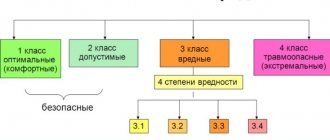Investigation of occupational diseases
Algorithm for establishing and procedure for investigating a chronic occupational disease of an employee. Investigation of acute occupational disease.
***
Chronic occupational diseases are diseases caused by harmful working conditions affecting the worker over a long period of time.
If the medical institution where the patient goes makes a preliminary diagnosis of a chronic occupational disease, it sends a notification to Rospotrebnadzor within 3 days.
Within a month after establishing a preliminary diagnosis of an occupational disease, the patient is sent to the occupational pathology center. He must have the following documents with him:
- extract from the medical record of an outpatient and (or) inpatient;
- information on the results of preliminary (upon employment) and periodic medical examinations;
- sanitary and hygienic characteristics of working conditions;
- a copy of the work book.
The sanitary and hygienic characteristics of the employee’s working conditions (SSH) are compiled by Rospotrebnadzor within 2 weeks after receiving the notification. Rospotrebnadzor sends the SGH to the employee, employer and medical institution that sent the notice.
The Center for Occupational Pathology establishes a final diagnosis of a chronic occupational disease and draws up a medical report.
A medical certificate is issued:
- employee (against receipt);
- to the insurer (sent);
- to the medical institution that referred the patient.
The Center for Occupational Pathology sends within 3 days a notice of the final diagnosis of an occupational disease (notice of cancellation or change of diagnosis within 7 days):
- to Rospotrebnadzor;
- employer;
- to the insurer;
- to the medical institution that referred the patient.
The employer, within 10 days from the date of receipt of notification of the final diagnosis of an occupational disease, forms a commission.
The commission investigates an occupational disease, based on the results of which, within 3 days after completion of the investigation, it draws up a report on the case of an occupational disease in five copies intended for:
- employee;
- employer;
- Rospotrebnadzor;
- center of occupational pathology;
- insurer.
The commission consists of five members. The commission includes:
- Head of Rospotrebnadzor – heads the commission;
- employer representative;
- occupational safety specialist;
- representative of a healthcare institution;
- representative of a trade union or other representative body authorized by employees.
To conduct an investigation, the employer must:
- submit documents and materials, including archival ones, characterizing working conditions at the workplace (site, workshop);
- at the request of the commission members, at their own expense, carry out the necessary examinations, laboratory, instrumental and other hygienic studies in order to assess working conditions in the workplace;
- ensure the safety and recording of investigation documentation.
During the investigation, the commission interviews the employee’s co-workers, persons who violated state sanitary and epidemiological rules, and receives the necessary information from the employer and the sick person.
The employer and Rospotrebnadzor keep the investigation report for 75 years.
In the event of liquidation of the enterprise, the employer transfers the act for storage to Rospotrebnadzor.
If the employer (his representative) or the injured employee disagrees with the contents of the report on the case of occupational disease (poisoning) and refuses to sign, he (they) has the right to set out his objections in writing, attach them to the report, and also send an appeal to a higher authority State Sanitary and Epidemiological Service.
The employer, within a month after the completion of the investigation, is obliged, on the basis of the act on the case of occupational disease, to issue an order on specific measures to prevent occupational diseases.
The employer notifies Rospotrebnadzor in writing about the implementation of the commission's decisions.
Acute occupational diseases are diseases provoked by one-time exposure to harmful conditions.
Investigation of acute occupational disease:
- The medical institution establishes a preliminary diagnosis of an acute occupational disease;
- The medical institution sends an emergency notification to the Rospotrebnadzor body, which supervises the facility where the occupational disease occurred;
- Rospotrebnadzor, having received an emergency notification, within 24 hours from the date of receipt, clarifies the circumstances and draws up a sanitary and hygienic description of working conditions;
- Rospotrebnadzor sends sanitary and hygienic characteristics of the employee’s working conditions to the medical institution at the employee’s place of residence or place of attachment;
- After receiving sanitary and hygienic characteristics, the medical institution establishes a final diagnosis of an acute occupational disease and draws up a medical report.
Legislation
Which workers may develop an occupational disease (list of professions), what responsibilities do employers have, are there state guarantees for sick citizens - these and other points are stipulated in several regulations of the Russian Federation:
- general information is provided by the Federal Law “On compulsory social insurance against accidents at work and occupational diseases” dated July 24, 1998 No. 125-FZ;
- The procedure for registering an occupational disease is established by the Regulations on the investigation and recording of occupational diseases, approved. Decree of the Government of the Russian Federation No. 967 of December 15, 2000;
- Resolutions of the USSR Cabinet of Ministers dated January 21, 1991 and the Council of Ministers dated August 22, 1956 approved two lists of positions and professions that were entitled to additional leaves, early pensions, and other benefits. List No. 1 contains professions identified by the Ministry of Labor as particularly difficult and dangerous. List No. 2 indicates specialties that negatively affect the health of employees, but are not considered particularly harmful;
- Order 417n is a list of occupational diseases, upon detection of which an investigation is initiated, the employee is provided with additional benefits, and free medical care is provided.
License in occupational pathology and examination of the relationship of the disease with the profession
Clause 3 of Order No. 36n once again* reminds that a medical organization that conducts an examination of the connection of a disease with a profession (hereinafter referred to as the occupational pathology center) must have a license for medical activities in the part of “examination of the connection of a disease with a profession.”
*We would like to remind you that regarding the examination of the connection between a disease and an occupation by occupational pathology centers, it is also necessary to be guided by the Procedure for the provision of medical care for acute and chronic occupational diseases (Order of the Ministry of Health of Russia dated November 13, 2012 No. 911n). This procedure also determines the procedure for organizing the activities of the occupational pathology center.
Procedure after the decision is made
Information about the decision made and a reasoned justification for the established diagnosis (if any) are reflected in the protocol of the medical commission and are entered into the patient’s medical documentation.
Based on the VK protocol, an employee authorized by the head of the occupational pathologist center, within one working day from the moment one of the decisions is made, draws up a medical report on the presence or absence of an occupational disease. The form of the medical report is provided in Appendix No. 2 to Order of the Ministry of Health of Russia No. 36n. The medical report is drawn up in 4 copies:
- one for the patient;
- the second – FSS of the Russian Federation;
- the third - the Ministry of Defense, which established the preliminary diagnosis;
- the fourth is stored for 50 years in the center of occupational pathology in honey. patient documentation.
Procedure for reporting acute health problems
The authorized bodies investigate and record all diseases caused by harmful production factors during the performance of direct labor obligations by employees in accordance with the order of management. Government Decree No. 967 applies to employees with an employment agreement or contract, students with an employment contract for the duration of their internship, and so on.
As soon as a preliminary diagnosis of “acute occupational disease” is made, the clinic urgently notifies the employer about this within 24 hours, as well as Rospotrebnadzor, which immediately begins to investigate the causes of the pathology. In this case, it is mandatory to prepare a sanitary and hygienic characteristic (SHC) of the working conditions of the victim, which is subsequently sent to a medical institution.
Having established the final diagnosis and probable causes of the disease, the medical institution is obliged to notify the insurer, Rospotrebnadzor, the head of the enterprise or individual entrepreneur and the clinic where the victim came from within up to 3 days. The date of detection of the pathology is the day when the final diagnosis was made. The employer has the right to disagree with the conclusions set out in the documents. However, the labor inspectorate is additionally notified of an incident at work.
Registration of an occupational disease step by step
How to register an occupational illness? This is described in detail in the Government Decree “On approval of the provisions on investigation...” dated December 15, 2000 No. 967. However, in practice many questions may arise, the main ones of which we will highlight in the article.
How to register an occupational disease The procedure for recording and investigating the circumstances of occupational diseases at work How to file a recourse for an occupational disease How to register an occupational disease As a result of work activity, in particular when working with harmful and/or dangerous substances, an occupational disease may be acquired (received). The employer and the state compensate for damage caused to the health of an employee through various compensation payments.
More than half of workers in Russia work in hazardous industries, 20% of them are women. Such conditions lead to negative consequences for the body and the development of occupational diseases. As a result, people lose their ability to work.
There are certain standards that must be followed by every employer. Let's consider what a hygienic assessment of working conditions in the workplace is.
Injured employees have the right to apply for temporary or permanent benefits as compensation for the harm received. They vary depending on the specific case. In this article we will provide a classification of occupational diseases and a list of payments that are due to sick employees.
How to prove the presence of an occupational disease after dismissal?
Upon termination of the employment relationship, the former employee’s right to establish the presence of an occupational disease is retained—the deadline for determining the issue has not been approved. The fact of assignment of payments is confirmed by Federal Laws No. 125 and No. 255 “On Compulsory Social Insurance”. According to their content, the victim can count on receiving compensation after termination of the contract.
It is worth noting that in this case, the establishment of the category of disability is the responsibility of the medical and social expert commission of the constituent entities of the country. The procedure for identifying the presence of an occupational disease does not change. The initiative to initiate the process is taken by the health care institution to which the citizen applied with health complaints.
How is a report on a case of occupational disease drawn up?
The corresponding act is drawn up in 5 copies and signed by all members of the commission. The head of the commission approves the document and certifies it with a seal.
The contents of the act are as follows:
- Circumstances that led to the occurrence of an occupational disease.
- Persons guilty of violating sanitary and epidemiological standards or other acts.
- The degree of guilt of the employee himself (in%) - if the disease was the result of gross negligence.
- Information about the nature of work under special conditions not specified in the documentation - according to the employee.
The victim has the right to refute the contents of the act if he does not agree with it and refuse to sign the document. To do this, he argues in writing the reasons for his refusal. His right in the future is to send an appeal to a higher authority of the State Sanitary and Epidemiological Service.
Within a month after signing the act, the employer must issue an order on measures to prevent occupational diseases and notify Rospotrebnadzor about the progress in implementing the commission’s instructions.
Regardless of how long ago the case of the disease is, the act can be restored or duplicated by Rospotrebnadzor if necessary.
Types and examples of occupational diseases
All occupational diseases are divided into acute and chronic. Acute ones include those that developed as a result of short-term harmful effects (during one working day or shift). In such cases, Art. 223 of the Labor Code of the Russian Federation obliges the employer to deliver the victim to the hospital or home on his own and at his own expense. Chronic diseases are those that arise as a result of the prolonged influence of one or more harmful factors on the body.
The following types of occupational diseases are distinguished:
Interesting information In order for an employee to begin receiving compensation or other payments that he needs to pay for his own treatment, it is necessary to conduct an investigation by a commission specially created by the head of the enterprise. It all starts with the employee receiving a preliminary diagnosis. He provides this document to his manager within 24 hours, as well as to Rospotrebnadzor, which can also be contacted by e-mail, registered letter or by telephone.
- Respiratory tract diseases – bronchitis, asthma. They occur in people who deal with chemical and synthetic products and phytoproducts. The most dangerous work is when the employee is forced to breathe dust of various origins.
- Diseases of the musculoskeletal system - chondrosis, curvature of the spine. They develop in people who spend most of their working time on their feet or sitting at a computer, as well as in those who lift heavy objects. At risk are hairdressers, office workers, cleaners, loaders, etc.
- Gastrointestinal diseases - gastritis, ulcers, colitis. The main reason for the development of such pathologies is a violation of the diet. This is most typical for office workers who do not have time to have breakfast and snack on cookies at work, washing them down with coffee. With poor nutrition, metabolism is disrupted, resulting in problems with the gastrointestinal tract.
- Skin diseases - eczema, dermatitis. Appears in workers who come into contact with substances harmful to the skin - fuels and lubricants, medications, dry phytoproducts.
- Injuries received at the workplace - burns, frostbite, wounds of varying severity, fractures, and other injuries.
According to Decree of the Government of the Russian Federation No. 967 of December 15, 2000, poisoning is also classified as an occupational disease.
The list of hazardous professions for early retirement is established by Decree of the Government of the Russian Federation No. 665 of July 2014. Let's find out what working conditions are considered harmful.









